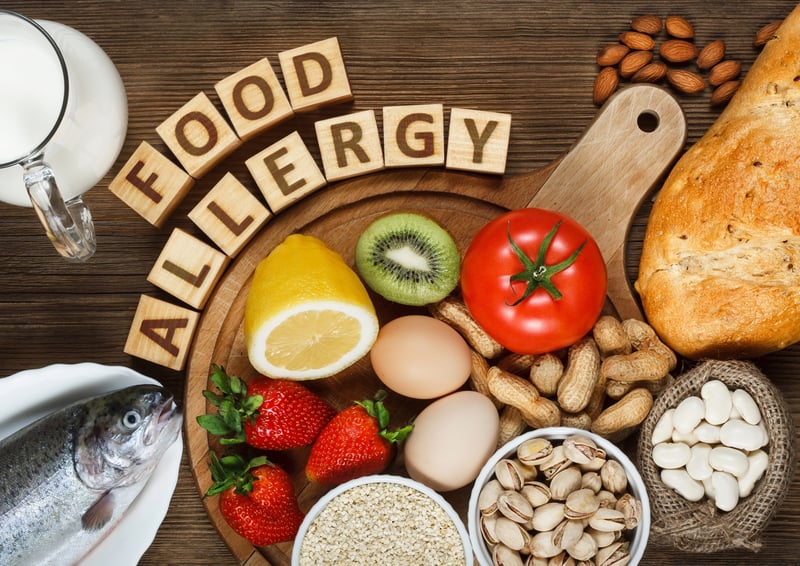Get Healthy!

- Posted May 8, 2023
Food Allergies: Testing, Management & Treatment
So, you ate a banana. You've eaten bananas countless times in the past. But this time, your tongue and lips are itching and your lip is a bit puffy.
If this happens to you, you are likely experiencing food allergy symptoms. You may have just joined the ranks of 32 million Americans who deal with food allergies. So, what do you do now?
Food allergies range from mild to life-threatening. Navigating dietary restrictions can be overwhelming, but with knowledge and tools, allergy management becomes more straightforward. Here, experts explore food allergies, their causes, risk factors, common allergenic foods, symptoms, testing, and management/treatment options.
What are food allergies?
According to the American College of Allergy, Asthma & Immunology (ACAAI), a food allergy is an abnormal immune response to a specific food protein. When the immune system misidentifies a food protein as dangerous, it produces an allergic reaction.
It's vital to know that symptoms can range from mild to severe, including hives, itching, swelling, stomach pain, vomiting and difficulty breathing. Some people may experience anaphylaxis, a potentially life-threatening reaction that can cause a sudden drop in blood pressure, trouble breathing and loss of consciousness.
What are the most common food allergens?
A wide range of foods can trigger food allergies, but eight foods account for most allergic reactions, according to the U.S. Food and Drug Administration. The most common food allergies are:
- Milk
- Egg
- Peanut
- Tree nuts
- Wheat
- Soy
- Fish
- Shellfish
Even trace amounts of these allergens can trigger an allergic reaction in sensitive individuals, so it's crucial to read food labels carefully and avoid cross-contamination with food allergens.
To help protect people with food allergies, the Food Allergen Labeling and Consumer Protection Act (FALCPA) of 2004 was put into place. This law demands that food manufacturers identify the presence of the eight major food allergens on product labels using plain language, making it easier for consumers to identify potentially dangerous foods. The law also requires that food manufacturers list any ingredients derived from these allergens.
Food allergy causes and risk factors
The exact causes of food allergies are still not fully understood, but several factors may increase the risk of developing food allergies. An article published by the International Journal of Environmental Research and Public Health indicates that some of the most commonly recognized food allergy risk factors include:
- Genetics: People with a family history of allergies
- Age: Infants and young children risk developing food allergies more than adults
- Environmental factors: Exposure to pollutants, certain medications or other environmental factors
- Gut microbiota: Disruptions in gut microbiota, the mix of bacteria that live in the digestive tract
However, Dr. Ruchi Gupta, director of the Institute for Public Health and Medicine -- Center for Food Allergy and Asthma at Northwestern Medicine in Chicago, indicated in her podcast that "about one in four adults said they developed an allergy as an adult and never had a food allergy as a child. So that's a lot of adults developing new allergies."
And research suggests that a combination of these factors may contribute to the development of food allergies. "Chances are there is not one factor ... it's going to be a group of factors and how our lifestyles have changed,"Gupta said.
Food allergy symptoms
As stated earlier, food allergy symptoms can range from mild to severe, including skin reactions such as food allergy rashes, gastrointestinal symptoms and respiratory distress. Here are some common symptoms of a food allergy, according to the Mayo Clinic:
- Mouth tingling or itching
- Development of hives, itchiness or eczema (food allergy rash)
- Swelling of the lips, face, tongue, throat or other body parts
- Experiencing wheezing, nasal congestion or difficulty breathing
- Feeling abdominal pain, nausea, vomiting or diarrhea
- Experiencing dizziness, lightheadedness or fainting
Symptoms of a food allergy can occur within minutes to hours after consuming an allergenic food and can vary from person to person. If you or someone you know is experiencing food allergy symptoms, it's vital to seek medical attention.
What happens during food allergy testing?
Food allergy testing involves various methods to identify specific foods that may trigger an allergic reaction. The ACAAI indicates that the most common methods to diagnose food allergies include skin-prick testing, blood tests, and oral food challenges.
During skin-prick testing, a small amount of the suspected allergen is placed on the skin, and a small prick is made to allow the allergen to enter the skin. If a raised, red bump or welt appears, it indicates the presence of an allergy. Blood tests can also measure the presence of specific antibodies to allergens in the blood. Oral food challenges are also growing as a course of food allergy treatment. These tests can help identify the specific foods that trigger allergic reactions, which can help people with food allergies avoid these foods and manage their symptoms.
Food allergy management and treatment
Avoiding allergenic foods altogether is the most effective way to manage food allergies. This may require careful reading of food labels, asking about ingredients when dining out and being prepared with an emergency plan in case of accidental exposure.
In case of accidental exposure, it's critical that you can recognize the symptoms of an allergic reaction and have access to appropriate treatment, such as epinephrine. The Cleveland Clinic indicates that other treatments for food allergies may include medications to manage symptoms and immunotherapy, which involves gradually increasing exposure to allergens to help desensitize the immune system.
If you suspect you or your child has a food allergy, consult a health care professional for proper diagnosis and management.



